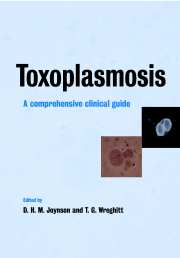Book contents
- Frontmatter
- Contents
- List of contributors
- Preface
- Historical perspective
- 1 Biology of toxoplasmosis
- 2 Immunology of toxoplasma infection
- 3 The epidemiology of toxoplasma infection
- 4 Infection in the immunocompetent
- 5 Toxoplasma infection in HIV-infected patients
- 6 Toxoplasma infection in immunosuppressed (HIV-negative) patients
- 7 Maternal and foetal infection
- 8 Prenatal screening for toxoplasma infection
- 9 Newborn screening for congenital toxoplasma infection
- 10 Infections in neonates and infants
- 11 Ocular infection
- 12 Laboratory diagnosis of toxoplasma infection
- 13 Antitoxoplasma chemotherapy
- 14 Toxoplasma vaccines
- Appendices: protocols for treatment and management
- 1 Suggested treatment protocols
- 2 Management of toxoplasma infection in pregnancy
- 3 Hygiene measures to prevent infection
- 4 Classification system and case definitions of Toxoplasma gondii infection in immunocompetent pregnant women and their congenitally infected offspring
- Index
11 - Ocular infection
Published online by Cambridge University Press: 24 September 2009
- Frontmatter
- Contents
- List of contributors
- Preface
- Historical perspective
- 1 Biology of toxoplasmosis
- 2 Immunology of toxoplasma infection
- 3 The epidemiology of toxoplasma infection
- 4 Infection in the immunocompetent
- 5 Toxoplasma infection in HIV-infected patients
- 6 Toxoplasma infection in immunosuppressed (HIV-negative) patients
- 7 Maternal and foetal infection
- 8 Prenatal screening for toxoplasma infection
- 9 Newborn screening for congenital toxoplasma infection
- 10 Infections in neonates and infants
- 11 Ocular infection
- 12 Laboratory diagnosis of toxoplasma infection
- 13 Antitoxoplasma chemotherapy
- 14 Toxoplasma vaccines
- Appendices: protocols for treatment and management
- 1 Suggested treatment protocols
- 2 Management of toxoplasma infection in pregnancy
- 3 Hygiene measures to prevent infection
- 4 Classification system and case definitions of Toxoplasma gondii infection in immunocompetent pregnant women and their congenitally infected offspring
- Index
Summary
Introduction
Focal retinochoroiditis is the most frequent outcome of infection of the eye by Toxoplasma gondii (Figure 11.1). The natural history of the disease is for an acute inflammatory lesion of the retina to slowly resolve, leaving a focus of retinochoroidal scarring.
The normal retina is transparent. Beneath this, the choroid is filled with blood, which is responsible for the red appearance. (As seen in the pupils when using flash photography.) Initially, the inflammatory cell infiltrate whitens the retina and may involve the overlying vitreous gel. As the inflammation regresses, focal destruction of the choroid reveals the underlying white sclera. The surrounding brown pigmentation of a healed lesion is due to replication of melanin-containing cells, which contribute to the healing process.
History
The first reported case in which the parasitic cysts of T. gondii were found within the retina was that of a child who died with hydrocephalus. Histology of the eyes revealed parasitic cysts in the retina adjacent to a ‘congenital coloboma’ of the macula (Janku 1923). However, the original basis for the statement that focal retinochoroidal scarring is due to T. gondii was the work of Koch et al. (1943), who reported the condition in six infected children and the pathology of three infected eyes. Vail et al. (1943) also described the condition in association with positive serological tests for T. gondii in older children and adults.
- Type
- Chapter
- Information
- ToxoplasmosisA Comprehensive Clinical Guide, pp. 277 - 295Publisher: Cambridge University PressPrint publication year: 2001

